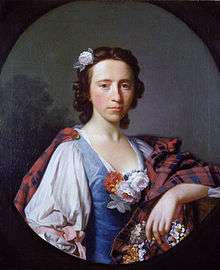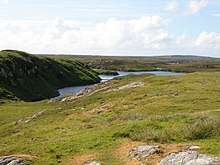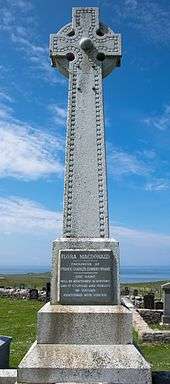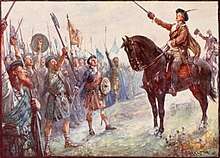Flora MacDonald
| Flora MacDonald | |
|---|---|
 Flora MacDonald by Allan Ramsay ca 1749–1750; the roses are a Jacobite symbol | |
| Born |
1722 Milton, South Uist, Scotland |
| Died |
4 March 1790 (aged 67–68) Kingsburgh, Isle of Skye |
| Nationality | British |
| Known for | assisting Charles Edward Stuart after his defeat at the Battle of Culloden |
| Signature | |
|
| |
Flora MacDonald (Gaelic: Fionnghal nic Dhòmhnaill); (1722 – 5 March 1790) was a member of the Macdonalds of Sleat, now remembered for helping Charles Edward Stuart evade government troops after the Battle of Culloden in April 1746. The Sleat Macdonalds supported the British government during the 1745 Rising and Flora later claimed to have assisted Charles out of sympathy for his situation. After his escape to France, she was arrested and sent to London where it was recorded 'all admired the dauntless part she had acted, and she had the honour of a visit from Frederick, Prince of Wales.'[1]
She was released under a general amnesty in June 1747 and later married Allan MacDonald, a professional soldier in the British army. They emigrated to North Carolina in 1773 but their support for the British government during the 1776–1783 American War of Independence meant the loss of their American estates; Flora returned to Scotland in 1779 where she died in 1790.
Early life
She was born in Milton on the island of South Uist in the Outer Hebrides, third and last child of Ranald MacDonald (d. 1723) and his second wife Marion, daughter of Flora and Reverend Angus MacDonald. Her father was a member of the minor gentry, being tacksman and leaseholder of Milton and Balivanich; she had two brothers, Angus, who later inherited the Milton tack and Ronald who died young.[2]
Flora's father Ranald died soon after her birth, and in 1728 her mother remarried Hugh MacDonald of Armadale, Skye. She was brought up under the supervision of her father's cousin, Sir Alexander MacDonald of Sleat and while it has been suggested she was educated in Edinburgh, this has not been confirmed; although some MacDonalds remained Catholic, particularly in the Islands, Flora was part of the Presbyterian majority.[3]
The escape of Charles Edward Stuart

Flora was visiting her brother on Benbecula in the Outer Hebrides when Prince Charles and a small group of aides took refuge there after the Battle of Culloden in June 1746. One of Charles' companions, Captain Conn O'Neill from County Antrim was distantly related to Flora and asked for her help.
Sir Alexander had not joined the 1745 Rebellion and Benbecula was controlled by a pro-government militia commanded by Flora's step-father, Hugh MacDonald. This connection allowed her to obtain the necessary permits but she apparently hesitated, fearing the consequences for Sir Alexander if they were caught. She may have been taking less of a risk than it appears, since witnesses later claimed Hugh advised the Prince on where to hide from his search parties and organised their passage to Skye.[4] Passes were provided allowing passage to the mainland for Flora, a manservant, Prince Charles disguised as an Irish maid, Betty Burke and a boat's crew of six men.
They left Benbecula on 27 June and landed at on Skye at Kilbride, near Sir Alexander's house at Monkstadt. Since he was absent, Lady Margaret arranged lodging for them with her steward, MacDonald of Kingsburgh, who told Charles to remove his Betty Burke disguise, as it simply made him more conspicuous.[5] The next day, they went to Portree, Skye, where Flora remained while Charles was taken to Glam on the island of Raasay. Two weeks later, the boatmen were detained and confessed, resulting in the arrest of Flora and Kingsburgh who were taken to the Tower of London.

After Lady Margaret interceded on her behalf with the chief Scottish legal officer, Duncan Forbes of Culloden, she was allowed to live outside the Tower under the supervision of a "King's Messenger" and released after the June 1747 Act of Indemnity.[6] A collection was taken for her by a number of aristocratic sympathisers, which eventually totalled over £1,500.[7] She later told Frederick, Prince of Wales and son of George II she acted from charity and would have helped him in the same way had he been defeated and in distress.[8]
On 6 November 1750, at the age of 28, she married Allan MacDonald, a captain in the army and Kingsburgh's eldest son.[9] The couple first lived at Flodigarry, Skye and inherited the family estate after Kingsburgh died in 1772.
Her bravery and loyalty gained her general sympathy, increased by her good manners and gentle character. Samuel Johnson, who met her in 1773, the year before she moved to America, described her as a woman of soft features, gentle manners, kind soul and elegant presence. He also paid the tribute engraved on her memorial at Kilmuir: ...a name that will be mentioned in history, and if courage and fidelity be virtues, mentioned with honour.
American Revolution
Allan MacDonald served in the 114th and 62nd Regiment of Foot during the 1756–1763 Seven Years' War. Unfortunately, he was a poor businessman who also quarrelled with his clan chief over increases in rent and in 1774, like many other MacDonalds, he and Flora emigrated to Anson County, North Carolina.[9] When the American War of Independence began in 1776, Allan raised the Anson Battalion of the Loyalist North Carolina Militia, which had a strength of some 1,000 men, including his sons, Alexander and James. They were marching to the coast to be picked up by British transports when they were attacked and scattered by an American force at the Battle of Moore's Creek Bridge on 28 February 1776.[10]
Allan was taken prisoner and for reasons that are unclear, only released in September 1777, after which he was posted to command a battalion of the 84th Regiment of Foot (Royal Highland Emigrants) at Fort Edward in Windsor, Nova Scotia.[11] Flora herself was evicted from Kiligray, lost all her possessions and suffered ill-health until allowed to rejoin her husband in August 1778.[12]
Return to Skye


After a harsh winter in Halifax, in September 1779 Flora took passage for London in the Dunmore, a British privateer; during the voyage, she broke her arm and ill-health meant she only returned to Scotland in the spring of 1780.[13]
Flora spent the next few years with various family members, including Dunvegan, her daughter Anne being married to Major General Alexander Macleod, the other main power on Skye after the MacDonalds.[14] The compensation paid to Allan MacDonald for the loss of their North Carolina estates was insufficient to allow them to settle in Nova Scotia and he returned to Scotland in 1784. As the Kingsburgh estate was now occupied by Flora's half-sister and her husband, Flora and Allan appear to have settled on the nearby tack of Penduin.[15]
She died in 1790 at the age of 68 and was buried in Kilmuir Cemetery, her husband following in September 1792. They had seven surviving children, two daughters and five sons, two of whom were lost at sea in 1781 and 1782; their son John made a fortune in India which allowed his parents to spend their last years in some comfort.[16]
Legacy
Traditional portrayals of Charles' escape such as The Skye Boat Song focus on the Prince, with Flora relegated to a secondary role and receiving less credit than is her due. She rarely spoke of the episode, her last contact with Charles being when they parted ways at Portree and it appears at least one motive was that his presence endangered her family.[17]

The Victorians created a Scottish identity expressed in cultural markers such as Burns Suppers, Highland Games and tartans, an obsession with raising statutes, and the adoption by a largely Protestant nation of the romantic Catholic icons Mary Queen of Scots and Bonnie Prince Charlie.[18] In 1878, Flora took her place in this pantheon with an alleged 'Autobiography' written by her granddaughter, Flora Frances Wylde, containing so many inaccuracies that it could not have been written by her.[19]
Her memory was popularised by Sir Harold Boulton's 1884 composition 'The Skye Boat Song,' with a bronze statue of her being erected at Inverness Castle in 1896.[20] Despite her Loyalist sympathies, a number of institutions were named after her in North Carolina, including Flora MacDonald College; from 1956, the college hosted the Flora MacDonald Highland Games, which were replaced in 2009 by the Scotland County Highland Games.
Flora was painted several times by Scottish portrait artist Allan Ramsay (1713–1784), who also produced a famous but now lost painting of Prince Charles at Edinburgh in 1745. The one that appears in this article was done after her release from the Tower in 1749–1750; in 2015, a second, previously unrecorded painting of MacDonald also by Ramsay was discovered in Florida.[21]
"Flora MacDonald's Fancy" is a Scottish highland dance choreographed in her honour, supposedly based on a dance she performed for Bonnie Prince Charlie. It is known for its balletic steps and graceful movements.
Fictional portrayals include;
- Sir Walter Scott, Waverley (1814); an early historical novel of the Jacobite rebellion in which the hero must choose between two women, one of whom, Flora MacIvor, seems modeled on Flora MacDonald. This impression is strengthened by the use of Allan Ramsay's portrait of Flora Macdonald for the cover of the Penguin (2007) edition of the book.
- Inglis Fletcher, The Scotswoman (1954) – a novel based on Flora MacDonald's life in North Carolina, during the American war of Independence.
- Highlander: The Series – in the 3rd-season episode, "Take Back the Night", Ceirdwyn, an Immortal, is living under the name of "Flora MacDonald" when Bonnie Prince Charlie and his party stop there on their way to the coast, and the boat to take him from Scotland.
- The Outlander series – the 6th book of Diana Gabaldon's Outlander series, "A Breath of Snow and Ashes", features an account of Flora MacDonald's arrival in the American colonies.
In the 1948 British historical film Bonnie Prince Charlie, Flora MacDonald is portrayed by Margaret Leighton, with Charles played by David Niven, who later recalled it as '...one of those huge, florid extravaganzas that reek of disaster from the start.'
See also
References
- ↑ MacLeod, Ruairidh (1985). Flora MacDonald: The Jacobite Heroine in Scotland and North America. Shepheard-Walwyn. p. 90. ISBN 0856831476.
- ↑ Douglas, Hugh (September 2017). "Flora MacDonald". Oxford DNB. doi:10.1093/ref:odnb/17432.
- ↑ Douglas, Hugh (September 2017). "Flora MacDonald". Oxford DNB. doi:10.1093/ref:odnb/17432.
- ↑ Riding, Jacqueline (2016). Jacobites; A New History of the 45 Rebellion. Bloomsbury. pp. 465–467. ISBN 1408819120.
- ↑ Riding, Jacqueline (2016). Jacobites; A New History of the 45 Rebellion. Bloomsbury. p. 467. ISBN 1408819120.
- ↑ Riding, Jacqueline (2016). Jacobites; A New History of the 45 Rebellion. Bloomsbury. pp. 468–469. ISBN 1408819120.
- ↑ Quyn, Dorothy Mackay (July 1941). "Flora MacDonald in History". The North Carolina Historical Review. 18 (3): 243. Retrieved 11 August 2018.
- ↑ MacLeod, Ruairidh H. (1995). Flora MacDonald: The Jacobite Heroine in Scotland and North America. London: Shepheard-Walwyn Publishers. p. 90. ISBN 0-85683-147-6.
Alexander MacGregor wrote that, 'All admired the dauntless part she had acted, and her case excited so much interest, that she had the honour of a visit from Frederick, Prince of Wales, father of King George III. His Royal Highness asked her how she had dared to assist a rebel against his father's throne? when she replied, with great simplicity but firmness, that she would have done the same thing for him had she found him in like distress. '
- 1 2 MacInnes, John (December 2009). The Brave Sons of Skye; Containing the Military Records (compiled From Authentic Sources) of the Leading Officers, Non-Commissioned Officers, and private soldiers whom "Eilean a' Cheo" has produced (Print On Demand ed.). General Books. pp. 15–24.
- ↑ McConnell, Brian. "A Highlander & Loyalist – Alan MacDonald" (PDF). UE.org. Mr McConnell's article provides third party references for the points included here. Retrieved 2 August 2018.
- ↑ Quyn, Dorothy Mackay (July 1941). "Flora MacDonald in History". The North Carolina Historical Review. 18 (3): 249–250. Retrieved 11 August 2018.
- ↑ McConnell, Brian. "A Highlander & Loyalist – Alan MacDonald" (PDF). UE.org. Mr McConnell's article provides third party references for the points included here. Retrieved 2 August 2018.
- ↑ Quyn, Dorothy Mackay (July 1941). "Flora MacDonald in History". The North Carolina Historical Review. 18 (3): 249–250. Retrieved 11 August 2018.
- ↑ MacGregor, Alexander (December 2009). The life of Flora Macdonald, and her adventures with Prince Charles (Print On Demand ed.). Nabu Press. p. 134.
- ↑ Quyn, Dorothy Mackay (July 1941). "Flora MacDonald in History". The North Carolina Historical Review. 18 (3): 253. Retrieved 11 August 2018.
- ↑ Douglas, Hugh (September 2017). "Flora MacDonald". Oxford DNB. doi:10.1093/ref:odnb/17432.
- ↑ Riding, Jacqueline (2016). Jacobites; A New History of the 45 Rebellion. Bloomsbury. pp. 465–467. ISBN 1408819120.
- ↑ Morris, RJ (1992). "Victorian Values in Scotland & England". Proceedings of the British Academy (78): 37–39.
- ↑ Douglas, Hugh (September 2017). "Flora MacDonald". Oxford DNB. doi:10.1093/ref:odnb/17432.
- ↑ Historic Environment Scotland. "Inverness, Castle Wynd, Statue Of Flora Macdonald (13434)". Canmore. Retrieved 26 January 2015.
- ↑ "'Flora MacDonald portrait' found in Florida". BBC News. 31 March 2015. Retrieved 22 July 2018.
Sources
- Douglas, Hugh; Flora MacDonald: The Most Loyal Rebel; (Sutton Publishing, 1999);
- Ewald, Charles; The Life and Times of Prince Charles Edward; (1886);
- Foote, William Henry; Sketches of North Carolina; (1846);
- MacLeod, Ruairidh; 'Flora MacDonald: The Jacobite Heroine in Scotland and North America;' (Shepheard-Walwyn, 1985);
- MacGregor, Alexander; The life of Flora MacDonald, and her adventures with Prince Charles; (Nabu Press, 2009);
- Riding, Jacqueline; Jacobites; A New History of the 45 Rebellion; (Bloomsbury 2016);
- Speck, WA; The Butcher; the Duke of Cumberland and the Suppression of the 45; (Welsh Academic Press, 1995);
- Toffey, John J; A Woman Nobly Planned – Fact and Myth in the Legacy of Flora MacDonald; (Carolina Academic Press, 1997;
- Walde, F.F; Autobiography of Flora MacDonald; (1870) – but see Talk Page on the validity of this work;
External links
| Wikimedia Commons has media related to Flora MacDonald. |
- Ascanius; or, the Young Adventurer
- Memorial plaque at Fort Edward (Nova Scotia).
- Rev. William Henry Foote, "Sketches of North Carolina" (1846) Links to: Cover, Contents xix, 80, 126, 134, Chapter XII pg148, 155 (return to NC in 1775)